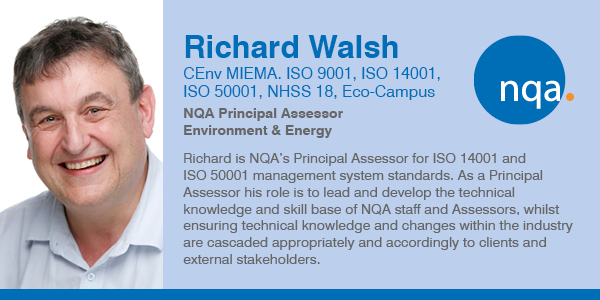Understanding the Organization and its Context from an Environmental Perspective
As with any journey in life, there must be a clear understanding of where we are starting from and where we want to get to. ‘Sat Navs’ tell us our starting point when they work out our route, however as yet no one has come up with technology to do this in terms of ISO 14001. That is why defining 'Organizational Context' is so important in Environmental Management System standards.
Context is a thorough determination and understanding of the internal and external issues that can impact an organisation and its objectives. It can be done for all organizations irrespective of size, industry or geographical location.
Put more simply - the expected outcome of ISO 14001 is ‘improvement in environmental performance’. There are things that will help achieve this and some things that will get in the way. Defining the context is simply working out and understanding what these are.
The EMS is then focussed on maximizing the positives and mitigating the effects of the negatives. Alongside this is an evaluation of those people or organizations that also may be affected by or have an interest in what you do.
A common criticism of previous versions of the standard was the lack of connection of environmental topics to everyday business operations. They were often viewed as separate and not relevant to many employees.
Thorough determination of organizational context helps solve this. By identifying internal and external issues, known as risks and opportunities they can be used to steer the strategic direction and purpose of the business. The management system then becomes a useful part of daily business and a relevant platform for employees to track their own performance.
Ensuring that this clause is fulfilled helps connect high-level company strategic goals to the tasks and work across all levels and functions. Although the standard doesn’t prescribe the method for determining the context of the organization, there are some logical steps and milestones.
What are internal and external issues?
Your organization's internal context is the environment in which you aim to achieve your objectives. Internal context can include your approach to governance, your contractual relationships with customers, and your interested parties.
Internal issues can include your:
-
Regulatory requirements
-
Strategies to conform to your policies and achieve your objectives
-
Relationship with your staff and stakeholders, including partners and suppliers
-
Resources and knowledge (e.g. capital, people, processes and technologies)
-
Risk appetite
-
Assets
-
Product or service
-
Other standards, guidelines and models adopted by the organization
-
Information systems
To understand your external context, consider issues that arise from your social, technological, environmental, ethical, political, legal and economic environment.
External issues may include:
-
Government regulations and changes in the law
-
Economic shifts in your market
-
Your competition
-
Environmental issues/perceptions
-
Events that may affect your corporate image
-
Changes in technology
Should we care about other people’s opinions?
In simple terms, the requirement for identifying relevant interested parties means that you need to decide whose opinion about your company you should care about.
Interested parties include direct customers, end users, suppliers and partners, regulators, and neighbours. Others could include people in the organization, owners/shareholders, and even society in general. These parties add value to the organization or are impacted by the activities within the organization. Identifying and meeting their needs is important to implementing an efficient and effective environmental management system. Their feedback can really help you to determine what can be improved in your organization, and how.
Your interested parties include customers, partners, employees and suppliers. When developing your EMS, you only need to consider interested parties that can affect your:
-
Ability to consistently provide a product or service that meets your customers' needs and any statutory requirements and regulations
-
Continual improvement process
-
Ability to enhance customer satisfaction through effectively applying your system
-
Process for ensuring you conform to your customers' requirements and any statutes or regulations that apply along with any other relevant commitments you have made.
Do I have to document it all?
One of the areas misunderstood by many with this clause is related to documenting the results of this clause. ISO 14001 uses the term ‘maintain documented information’ whenever there is a formal requirement to document something. The standard does not make that declaration for this clause or its outputs.
The Annex of the standard (A4.1) details that the intent of this clause is to provide a ‘high level, conceptual understanding’ of the relevant and identified issues.
Of course, clauses later in the standard building on the foundation set by this clause do require documenting such as the risks and opportunities that need to be addressed.
When and if do I have to review it?
ISO 14001:2015 clause 9.3 (management review) states that the review process shall include consideration of changes in:
-
External and internal issues that are relevant to the EMS
-
The needs and expectations of interested parties , including compliance obligations
These of course are the two main areas covered in ISO 14001:2015 clause 4 - ‘Context of the Organization’.
In summary
The introduction of this clause has ensured that the EMS is no longer dictated by the standards, internal/external auditors or the environmental manager. Instead, it is the top management in an organization that is empowered, providing them with the authority and flexibility to define their management system and ensure that it meets the expected outcome - an improvement in the environmental performance of their organization.
Authored by: Richard Walsh, NQA UK Principal Energy & Environment Assessor

To check out what ISO 14001 Environmental Management training NQA offers click here.

